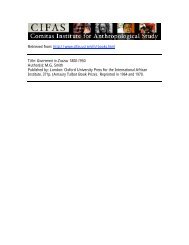Slaves, Free Men, Citizens - CIFAS
Slaves, Free Men, Citizens - CIFAS
Slaves, Free Men, Citizens - CIFAS
- No tags were found...
You also want an ePaper? Increase the reach of your titles
YUMPU automatically turns print PDFs into web optimized ePapers that Google loves.
. -Socialization and Personality Structuretion, extremely childlike, a qdty which m y NU@among others, often remarked 00.- Quubee was Â¥hofrom all reports. gay, happy-go-lucky, frivolous and cheerful.To Stewart, 'He is patient, cheerful, and commonlysubmissive, capable at times of grateful attachments whereuniformly well treated, and kind and affectionate towardhis kindred and offspringss.^ And Sir John Keane foundit 'a most extraordinary thing* that 'they are always singing,and seem excessively delighteds.* But Quashee'idarker traits were stressed just as often. He was revengeful,harbouring grudges for a long tinu; when placed in positionsof authority he was likely to be extremely cruel andtyrannical; he was 'possessed of passions not onlybut ungovemble . . . a temper extremely irascible; a diapositionindolent, wiflsh and deceitful; fond of joyomsociality: riotous mirth and extravagant show'.ÃIn addition, the contemporary accounts almost all attributean element of stupefaction to Quashee, and an almostcomplete lack of judgment. Quashee somehow managedto do everything wrongly. Repeated attempts at correctionwere doomed to failure. Lewis, despite his fondness forhis slaves, wrote toward the end of his journal that, 'Somehowor other, they never can manage to do anything quiteas it should be done. If they correct themselves in one re--ipect today, they are sure of making a blunder inother manner tomorrow*.TO This stupidity was often quiteconsciously feigned, as Madden makes clear:It is a difficult thing to get a Negro to understand anythingwhich he does not wish to hear; the more you tryto explain a matter that is disagreeable to him, the moreinca~able he a- of comprehension; or if he finds-1907); see for example p. 288."Stewart, Account of Jamaica, pp. 234-35.ÑHous of Lords Committee on Slavery, 1832, Evidence ofSir John Keane, House of Lords Sessional Papers, Vob. 106-7,p. 179.McNeill, op. eft., p. 28.! TO Lewis, op. cit., p. 392.Orlando Patterson41 --ihu plan ineffectual, be endeavoun to lender the mattorridleu% and his talent at rendering ridido Ñrcftdiis really s~rprising.~lOn the other hand. several pcnetrathg ohservem did notfail to notice the acuteness of the slave h judhg thecharacter of those about him. Phillippo noted, for example.that, 'so far from being more ddcient in acutenw anddiscrimhation than other men, none can penetrate moredeeply than the Negro into the character, or form us ophionof strangen with greater conectoess and precision'.'*That Quuhee existed there can be no doubt, The problemia to ascertain how real, how meaningful, this psychologicalcomplex was in the life of the slave. A full answerto thin question would involve a dimion into existentialmd role psychology which is outside the confine* of thiswork."We may, however, make a few tentative obaer-vations.Quashee may be said to have existed on three leveh.First, as a stereotyped conception held by the whites oftheir slaver secondly, at a response on the paft of the staveto this stereotype; and thirdly, as a psychofogicaJ functionof the leal life situation of the slave. All three leveh ofQuasbee's existence were closely related and mutually rehforcedeach other.Ift ill begin wHh the third level TIM real life situationof the slave, as we have shown, was one in which there wma cmplete breakdown of all major institutions-the family..-TIR. R Madden, Twelve Monthd Risbteme fn the WenIndies during the Transition from Slavery to ApprentkulHp12 mlÈ Philadelphia. Londoo. 1835). Vol. 2, pp. 155-56.J. M. PhilUppo. Jamaica: lts Part and Pfwnt Sum (Leal:John Snow, 1843). p. 204. Stniltrty it irn off remarfcedb slave OU'tIClX h8t k Nem Wdml& 8man bettor than UK white nun wdentuib (he New (UlricB- Phillipe, American Negro Slavery, p. 327).For an extnoiely suggestive analyiit of similar penooalitymlikx~l QuiilKe. ice R. D. Lifag's dbcunion of -Die fthftdf mkm' in Chapter 6 of his book, The Divided Self. &a h J. P .ftirtnt'r analysis of 'bad faith' hi hi* Beiw ami Norhingnw.





